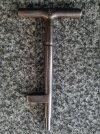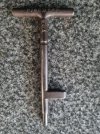High Dyke
Established Member
I was asked about the mystery key (as shown in the photos). It is marked Highdyke Box, on.one side, and the number 3 on the other.
Discussing with railway colleagues, both retired and present has not yielded any answers as to what it was used for. It isn't a door key. I post this to a wider audience.


Discussing with railway colleagues, both retired and present has not yielded any answers as to what it was used for. It isn't a door key. I post this to a wider audience.


